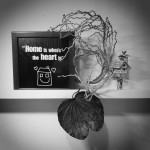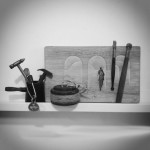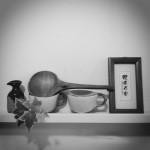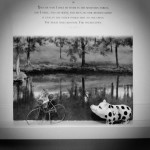Apart from being an aesthetic philosophy, slow Living is also a choice of lifestyle. Authors Beth Meredith and Eric Storm summarize slow living as follows: Slow Living means structuring your life around meaning and fulfillment. Similar to “voluntary simplicity” and “downshifting,” it emphasizes a less-is-more approach, focusing on the quality of life. [9]
Slow Living addresses the desire to lead a more balanced life and to pursue a more holistic sense of well-being in the fullest sense of the word.
The series of “In Praise of Slow” features graphical or painting collages of installations originating from my personal collections. They were derived from thoughts in my mind, about “Slow Living” with a sense of Wabi-Sabi, a philosophy that has recently fascinated me as a busy city-dweller. [10]
With “Slow Living” as the newest incarnation of the simplicity movement, the search for fresh inspiration on the ways to live a more authentic life became even more important to me. Turning to Eastern traditions, many people are discovering the Japanese concept of Wabi-Sabi life-style.
Acting as a perfect antidote to today’s frenzied, consumer-oriented culture, Wabi-Sabi encourages slowing down, living modestly, and appreciating the natural and imperfect aspect of the material culture. While defying definition, Wabi-Sabi in art is best expressed in brief, evocative bite-sized moments of expression.
Intended food for thought for viewers: Having lived and worked in a fast-paced city like Hong Kong for many years, I could not help but wonder what would happen if we all slowed down our pace a bit to discover and appreciate the natural aesthetics and organic compositions of the little things around us.
[9] Slow Living introduced by Authors Beth Meredith and Eric Storm, Meredith, Beth and Storm, Eric. “Slow Living – Learning to Savor and Fully Engage with Life”. Create-The-Good-Life.com. 2009. Retrieved 2011-3-20. https://en.wikipedia.org/wiki/Slow_living
[10] Diane Durston, Wabi Sabi: The Art of Everyday Life, (Aug 1, 2006)










